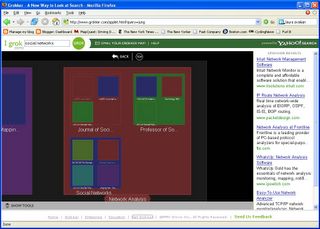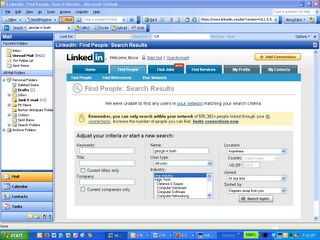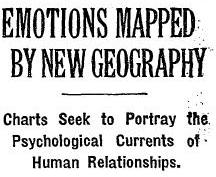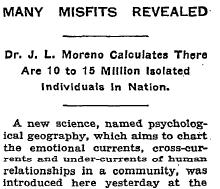Tuesday, May 31, 2005
The Network Roundtable is off and running
• Client Connectivity: Generating Value at the Client Interface with Network Analysis
• Innovation: Driving Innovation and Top Line Revenue Growth with a Network Perspective
• Leadership Development: Enhancing Leadership Effectiveness and Resilience via Network Management
• Organizational Change: Facilitating Large Scale Change with a Network Perspective
• Well-Being at Work: Promoting Employee Well-Being through Relational Constellations at Work
• Communities of Practice: Assessing and Supporting Communities of Practice with Network Analysis
For a close-up look at Organizational Change, be sure to follow Patti Anklam's blog. She is co-leading that particular project with Nat Welch.
Friday, May 27, 2005
Mining Social Networks from Email
My regular readers may have already detected that I am a New Yorker magazine junkie. My friends can hardly fail to notice this, since I am always saying, "Yes, and that reminds me of an article I just read in the New Yorker," at which point I take over the conversation for a few minutes. In the olden times (before today) that was more than enough for my friends. But as of today it is just the beginning. Now I can go home to my personal NYer archives (dating from 9-11), grab the issue in question, put it through my scanner, and sit back while my computer receives the entire article in the form of a Word document (with columns, pages, and cartoons all properly configured) or a PDF (with text searching). I leave the rest of the story to your imagination, since this is a copyright-friendly blog.
If any of you just happen to be thinking about email right now, let me say--that reminds me of a great article I just read in the New York Times: "Enron Offers an Unlikely Boost to E-Mail Surveillance." I am a bit embarassed to be mentioning this article now. It was published very prominently on Sunday. But I have been so preoccupied with my new ThinkPad that real life is apparently passing me by. So thanks to Jim Murphy for clipping the article and handing it to me, in a quaint nod to life before scanners. Jim's gift prompted me to check Patti Anklam's blog and see her review of the article which she wrote the day after its publication.
The gist of the story is that a huge pile of Enron email is now publically available. The email provides a detailed look at communication from before the California energy crisis right up to the final bankruptcy scandal. This is an unprecendented resource for sociologists and computer scientists, who have proceeded to demonstrate not only the power of textual analysis (how often do people say "Dynergy" or "bankruptcy" week by week) but also the power of network analysis (who sends email to whom and when, regardless of the content).
The article features a beautiful network diagram:
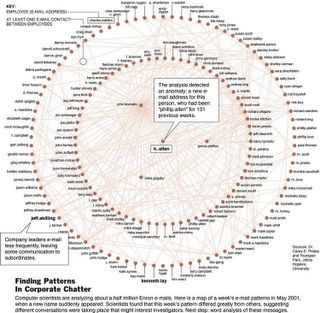
The Enron analysis is being led by David Skillicorn, Kathleen Carley, and Michael Berry.
Want to try this at home? You can! Investigate your own email communication network by downloading Peter Gloor's TeCFlow.
Wednesday, May 25, 2005
Health Information Liquidity
This is the starting point of the exciting idea of "health information liquidity." I caught a hint of this idea listening to Tim Andrews introduce himself to a group several weeks ago. Just yesterday I finally sat down with Tim to hear about his work in more depth.
Tim is part of Transform Partners, which has joined forces with The Work Foundation to promote discussion about health care liquidity at the highest levels. Here is a nice article about the project and its goals, including a story illustrating how sharing our health records can protect us when we travel, drive significant advances in medical research, and earn us financial dividends as a result. (The analogy to financial liquidity seems to go pretty far.)
IBM's Almaden Institute hosted an all-star panel discussion on this topic a few weeks ago. Perhaps that's what caught James Surowiecki's eye. See "Local Knowledge," the latest installment of his weekly New Yorker column, for an unflattering look at information flow in healthcare. After describing the shocking degree to which the medical care you receive depends on where you happen to be at the time, Surowiecki concludes:
"In most professions... competition insures that, over time, good ideas are diffused through the whole system: people who don’t absorb and adapt fail. But medicine, which is in some ways quintessentially modern, is in other ways a throwback, a bastion of parochialism in a globalized age."
Tuesday, May 24, 2005
Subtleties of Centrality

Centrality is one of the most basic social network concepts across the galaxy. And yet even for us professional social network analysts, this basic concept seems surprisingly slippery.
For those of you who have never thought about centrality formally, let me introduce you to the slipperiness with a little game: Who is the most central person in the network below?
Did you guess (1)? This person has more direct connections than anyone else. Or perhaps you guessed (6)? This person has fewer direct connections than (1) but is more central in the sense of influencing network-wide communication as it transfers through him.
The above puzzle is just the beginning of the surprising subtleties of centrality. To help us explore more deeply, Steve Borgatti recently published a basic checklist of questions we should ask before measuring centrality in our networks. These questions break into two families, approximated below:
One: What is the fundamental commodity that flows through the network? Is the commodity like a physical object that can only be in one place at a time? Or does it generate copies of itself (like an idea) and so occupy many places at once?
Two: What kinds of trajectories does the commodity follow through the network? Can it sensibly visit the same person or relationship more than once (like a dollar bill) or does it proceed directly from source to destination?
After presenting his checklist, Borgatti then surveys the literature on centrality. Here we find a bewildering array of formulae with names like degree, closeness, betweenness, information, and eigenvalue. Borgatti explains how each centrality measure assumes a certain set of answers to his two-dimensional list of questions. The resulting table exposes how centrality measures developed with one set of assumptions in mind are often applied to networks where these assumptions completely break down. For example, betweenness centrality assumes a network where flow moves along the shortest possible path from source to destination (like a package), and yet it is commonly used to measure influence in scenarios where shortest paths are hardly the only ones that matter. (Rhetorical question: Is the shortest path between HIV and you the only one you care about? Or do you care about all possible paths?) Borgatti’s table also exposes gaping holes in our understanding of centrality—for example, there are no established centrality measures for gossip or support networks.
For more on centrality, see Borgatti’s “Centrality and network flow” and other excellent articles in Social Networks 27 (2005) 55-71.
Friday, May 20, 2005
Grokker Maps the Information Community
Social network analysts aren't the only people interested in finding natural community clusters. Another great application is making sense of all the information on the Internet. I've been talking about that indirectly in this thread on Internet visualization, hoping all the while that some Internet techie would put these pieces together.
Of course, someone did put those pieces together several years ago, and I just found out about it today. I am happy to report that Grokker is here. Here's a nice article about it in a recent issue of the International Herald Tribune, which explains:
"Groxis, a San Francisco-based company that was founded in 2001, has converted its desktop Grokker software program, which displays a Web search as a series of categories set in a visual map, to run as a Java plug-in for browsers.
Below I show how Grokker gives me a nine-category breakdown of my query "social networks," including topics like "dynamics," "network analysis," "social capital," and "social software":
Then I can zoom in on the category of my choice, such as "network analysis," where I get to see topics like "journals," "professors," and "social networks":
At any point I can select a specific web page, which brings up a descriptive balloon of text and the appropriate link info in a sidebar:
Wednesday, May 18, 2005
Commercializing social networks
First I heard from Edward Vielmetti who shared several ways he has found LinkedIn to be helpful. Interesting. That was enough to get me back on the LinkedIn site for another test drive. There I discovered the new LinkedIn Outlook toolbar, which I downloaded. Below you can see LinkedIn kicking into high gear after I inquired (in Outlook) if George W. Bush is in my contact list:
Unfortunately W and I seem to be even more than six degrees apart.
Nice things about the LinkedIn Outlook toolbar: It makes it easier than ever to keep your Outlook contact folders up to date. It can scan your email archives and suggest new additions to your contact database. It also features a way-cool "Grab It" feature where you can drag your mouse over someone's email signature (or any other text) and it will quite skillfully create an Outlook contact entry based on that text. All these features make Outlook easier for me, regardless of what I get out of LinkedIn.
Of course, the LinkedIn Outlook toolbar also makes it easier than ever to upload your contacts from Outlook into your LinkedIn profile. If I ever actually connected with people through LinkedIn, this would be fantastic. For now, that part is kind of like an arcade game where I compete with friends and colleagues to see who can score the most connections.
When LinkedIn talks to Microsoft about developing this concept further, it's scary to contemplate where it can go (scary good and scary scary). It will be fun to watch how this plays out, and don't forget about Visible Path.
Tuesday, May 17, 2005
Barry Wellman's Net Lab: Community Central
Barry has an extremely high degree of what is technically refered to as "centrality."* In layman's terms, that means that when Barry says "Connectedness is OK," the result is more traffic in two days than Connectedness had seen in the entire previous month.
In contrast, when I say "Barry Wellman's Net Lab is a fantastic compilation of research on how the Internet affects everday life," chances are that Net Lab's web servers will not strain perceptibly under the additional traffic I refer their way.
Astute readers may be wondering, "Is centrality really the whole story?" That's a good question, and the answer depends in part on how we decide to define "centrality."
The funny thing about centrality is that it is so central to our intuition about social networks and yet it is not easy to pin down with mathematical precision. This is partly due to computational complexity, but mostly I think it's because we're so used to thinking informally about centrality that even after we think we've formalized it, we still forget to verify the sensibility of our equations. That's a message I recently took away from Steve Borgatti's paper "Centrality and network flow," Social Networks Vol. 27, issue 1 (Jan 2005). I'll say more about that soon.
*
PS -- See David Knoke's SNA Course Syllabus for more well-done materials like the centrality handout I referenced above. David teaches sociology at the University of Minnesota.
Thursday, May 12, 2005
Social Network Analysis Master Class June 13-15
So says the flier for an upcoming SNA master class, and I couldn't agree more. The master class aims to give experienced consultants hands-on experience and a big push up the steep learning curve of SNA.
The class will run June 13-15 at Boston College's Carroll School of Management. It will be taught by Inga Carboni and Pacey Foster, and will feature guest appearances by luminaries Steve Borgatti, Bill Torbert, and Patti Anklam.
I attended a wonderful two-day UCINET seminar taught by Inga a few months ago and recommend this workshop as a great way to get up to speed with SNA.
Tuesday, May 10, 2005
Social Networks Get Serious
I am pleased to hear this but confess that I still don't see anything I would pay for on LinkedIn, which is featured prominently in the article as a well-funded social network software startup.
Thursday, May 05, 2005
Annotated Bibliography of Social Network Analysis for Business
While we were preparing for our recent presentation to the Mass Bay OD Learning Group, Patti Anklam shared with me a comprehensive SNA bibliography she had assembled and organized by topic, like so:
- Social and personal networks in organizations
- Communities of practice
- Networks, business, and knowledge management
- Organizational networks research
- The science of networks
- SNA textbooks
- Brief readings and articles
- Websites and blogs
OK just a little bit of further ado. If you read only one book, start with The Tipping Point by Malcolm Gladwell. Then when you're ready for more, here's your list:
Social Network Analysis Bibliography
By Patti Anklam and Bruce Hoppe
Quoted Reviews from Amazon.com
May 2005
Social and personal networks in organisations:
The Hidden Power of Social Networks,
The Quantum Theory of Trust, Karen Stephenson, Prentice Hall, 2005. “Companies around the world are beginning to learn that they can profit by analyzing invisible social networks, and understanding their impact…. Stephenson introduces the analysis of networks to identify the personalities and patterns of organisations, and shows how to manage the personal currency that counts in good networks: trust.”
The Social Life of Information, John Seeley Brown and Paul Duguid,
In Good Company, How Social Capital Makes Organizations Work, Don Cohen and Laurence Prusak, 2001. "The book's novelty and appeal lie in the . . . attention to the power of commonplace conversations. . ." “providing insight into the causality between a company's social atmosphere and its success.”
Achieving Success through Social Capital, Tapping the Hidden Resources in Your Personal and Business Networks, Wayne Baker, Jossey Bass Publishers, 2000. “Here, an expert on building connections shows how building social capital produces higher pay, faster promotions, better jobs, breakthrough ideas, new business opportunities, and profitable companies.”
Communities of Practice:
Cultivating Communities of Practice,
Leveraging Communities of Practice for Strategic Advantage, Hubert Saint-Onge and Deborah Wallace, Butterworth Heinemann, 2003. “combines theory and practice to outline a model for developing successful communities of practice and proposes a direction for establishing communities of practice as an integral part of the organizational structure.” “Written in thick clotted prose.”
Communities of Practice: Lessons from Leading Collaborative Enterprises
Networks, business, and knowledge management:
Living Networks, Ross Dawson, Financial Times/ Prentice Hall, 2003. “provides a lucid and visionary framework in which to chart a succesful company or individual course in the Knowledge Economy.” “More practical than Allee’s book.”
The Future of Knowledge: Increasing Prosperity through Value Networks. Verna Allee, Butterworth Heinemann, 2002. “Overall, the book offers a fresh, thought-provoking look at what have become already become well-worn concepts in the knowledge management field. Allee has synthesized a diverse array of ideas and concepts and theories from multiple disciplines to this work.”
The Wealth of Knowledge: Intellectual Capital and the Twenty-first Century Organization, Thomas A. Stewart, Currency Doubleday 2001. “While not groundbreaking, his latest book offers a broad survey of business from the intellectual capitalist's perspective, from the basic economics of knowledge and business organization theory and management to selling and accounting for knowledge. Stewart could have fit this subject into a serious business magazine article; in expanding it, he simply adds a relentlessly upbeat mix of grand metaphors and detailed examples.”
The Information Ecology, Thomas A. Davenport and Laurence Prusak,
Lost Knowledge: Confronting the Threat of an Aging Workforce, David W. DeLong,
The Trusted Leader, Robert Galford, Free Press 2002. “A knitting-together of management theory, real-life anecdotes and snappy tools and self-assessment quizzes, the book tries gamely to be both authoritative and accessible. Its strongest section is a discussion of the "enemies of trusted leadership"-office archetypes ranging from power-hungry control freaks to underperforming slackers-who can undermine what a CEO is trying to achieve.”
The Wisdom of Crowds: Why the Many are Smarter than the Few and How Collective Wisdom Shapes Business, Economies, Societies and Nations, James Surowiecki, Little Brown 2004. “"Wise crowds" need (1) diversity of opinion; (2) independence of members from one another; (3) decentralization; and (4) a good method for aggregating opinions…. Surowiecki's style is pleasantly informal, a tactical disguise for what might otherwise be rather dense material. He offers a great introduction to applied behavioral economics and game theory.”
Organizational networks research:
Knowledge and Social Capital: Foundation and Applications, Eric L. Lesser (Editor), Butterworth Heinemann, 2000. “Knowledge and Social Capital explains how social capital can drive collaboration, reconcile an organization's internal and external labor markets, and improve organizational effectiveness. This edited compilation of authoritative articles helps readers understand how they can build and capitalize on their own organizations' social capital.”
Networks in the Knowledge Economy,
The science of networks:
Six Degrees, The Science of the Connected Age, Duncan J. Watts, W.W. Norton, 2003. “A network of discoveries across an array of disciplines tell the story of an explosive new field of knowledge, the people who are building it, and Watt's own peculiar path in forging this new science.”
Nexus, Small Worlds and the Groundbreaking Science of Networks, Mark Buchanan, Norton, 2002. “presents the fundamental principles of the emerging field of 'small worlds' theory--the idea that a hidden pattern is the key to how networks interact and exchange information, whether that network is the information highway or the firing of neurons in the brain.”
Linked, The New Science of Networks, Albert-László Barabási, Perseus Publishing 2002. “First book to explore the hot new science of networks and their impact on nature, business, medicine, and everyday life. This book has a simple message: think networks. It is about how networks emerge, what they look like, and how they evolve.”
Social Network Analysis Texts
Social Network Analysis: A Handbook, John Scott, Sage Publications 2nd Edition 2000. “provides an accessible introduction to the theory and practice of network analysis in the social sciences. It gives a clear and authoritative guide to the general framework of network analysis, explaining the basic concepts, technical measures and reviewing the available computer programs.”
Social Network Analysis: Methods and Applications,
Structural Holes: The Social Structure of Competition. Ron Burt,
Managing the Flow of Technology: Technology Transfer and the Dissemination of Information of Technological Information with the R&D Organization, Tom Allen, MIT Press 1997. “summarizes more than a decade of work on communications flow in science and engineering organizations, showing how human and organizational systems could be restructured to bring about improved productivity and better person-to-person contact.”
Brief Readings
• "The People Who Make Organizations Go--or Stop" Laurence Prusak;
• "Making Invisible Work Visible:Using Social Network Analysis to Support Strategic Collaboration" by
• “Karen Stephenson’s Quantum Theory of Trust,” Booz-Allen’s strategy+business, Vol 29, 2003.
• “Informal Networks: The company behind the charts,” David Krackhardt and Jeffrey Hanson, Harvard Business Review, July-August 1993
• “How Networks Reshape Organizations for Results,” Ram Charan, Harvard Business Review September-October 1991
• “What Creates Energy in Organizations?”
• “A Practical Guide to Social networks,”
• “KM and the Social Network,” by Patti Anklam. Knowledge Management Magazine, May 2003.
• “A Relational View of Information Seeking and Learning in Social Networks,” Borgatti, S.P. and Cross, R. 2003. Management Science. 49(4): 432-445.[pdf]
• “Knowing What We Know: Supporting Knowledge Creation and Sharing in Social Networks,” Cross, R., Parker, A., Prusak, L. & Borgatti, S.P. 2001. Organizational Dynamics 30(2): 100-120. [pdf]
• “Beyond Answers: Dimensions of the Advice Network,” Cross, R., Borgatti, S.P., & Parker, A. 2001. Social Networks 23(3): 215-235. [pdf]
• “A birds-eye view: Using social network analysis to improve knowledge creation and sharing,” Cross, R.L., Parker, A. and Borgatti, S.P. 2000. Knowledge Directions. 2(1): 48-61. [pdf]
Web Sites and Blogs
•
• Valdis Krebs: http://www.orgnet.com/
• Stephen Borgatti: http://www.analytictech.com/
• Bruce Hoppe: http://connectedness.blogspot.com/
• Wikipedia: http://en.wikipedia.org/wiki/Social_Network_Analysis
• Patti Anklam: http://www.byeday.net/
Research and the SNA Community
Wednesday, May 04, 2005
The Tipping Point of Organizational Change
Interestingly, this rather extensive "Tipping Point" website contains not a single mention of Malcolm Gladwell, author of "The Tipping Point" and certainly the reason this phrase is so popular today. But, as reported here earlier, Gladwell is genuinely flattered when his ideas are put to good use, with or without attribution.
Tuesday, May 03, 2005
Stanley Wasserman and Visible Path
You can download the whole article right here.
Wasserman is not only a professor at Indiana University but also Chief Scientist for Visible Path. I first heard about Visible Path when their corporate blog Centrality came out. I recommend you pay it a visit, and then check out the rest of what Visible Path has lined up. It's kind of like LinkedIn on steroids. Their system digests your entire Outlook database (with your permission, of course) and continually monitors all electronic communication among participants. Then when you want to reach a sales prospect (the primary application of Visible Path at this point) the system will recommend the best route to an introduction. Wasserman has apparently created some sophisticated (and proprietary) calculations to inform this recommendation.
Also, if you're a sucker for slick Flash demos, then you have to visit Visible Path just to see theirs. These folks have clearly put a lot of thought into more than statistics.


